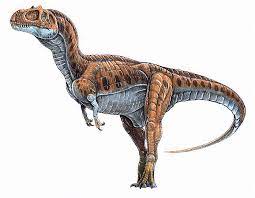
Eustreptospondylus Dinosaur is a genus of theropod dinosaur that lived in England during the Middle Jurassic Period. It was first discovered by Richard Owen in 1858 and began to gain attention in 1902 when its type species, Eustreptospondylus oxoniensis, was fully described. Eustreptospondylus was a relatively small predator measuring three to four metres in length. Its body mass was estimated at around one hundred kilograms. The most defining characteristic of Eustreptospondylus was its unique vertebra, which was unusually tall and had a distinct ridge on the bottom. This feature has led to this dinosaur being classified as a eustreptospondylid, related to the clade of dinosaurs that includes the Megalosauridae and Allosauridae.
The skull of Eustreptospondylus was fairly small, approximately 30cm in length. It had a triangular nasal crest between its eyes and a tall, thin crest on its forehead. The jaws were lined with small serrated teeth and the upper jaw had a blunt tip. The teeth were suitable for slashing and gripping prey, suggesting that it was a carnivore. The limbs of Eustreptospondylus were long and slender, much like those of modern reptiles. Analysis of fossilised footprints left by Eustreptospondylus indicates that it moved by running on two legs. Its tail was stiff and long, used for balance when turning and braking.
Eustreptospondylus Facts :
| Name: | Eustreptospondylus Dinosaurs |
| Size: | 3-4 meters |
| Main Facts: | It is one of a small number of theropod dinosaurs to have been discovered in Europe, indicating that the region was home to a variety of prehistoric creatures. |
Eustreptospondylus is known to have lived in Europe during the middle Jurassic period, around 160 million years ago. It inhabited the sandy river banks and floodplains of what are now England, Scotland, and Wales. Its remains have been discovered in numerous sites, such as a toe bone in Scotland and a few bones in England. Eustreptospondylus was likely a solitary hunter in its natural environment, relying on its speed and agility to capture prey. It probably hunted small animals such as lizards and fish, as well as large insects like dragonflies and locusts. Despite its small size, Eustreptospondylus could still prey upon larger animals if it found them alone or weakened, such as juvenile sauropods.
Eustreptospondylus was similar to its relatives like Megalosaurus and Allosaurus, but its tall vertebrae and unique skull structure help set it apart. Its slender frame and agility suggest that its lifestyle was that of an ambush predator, sneaking up on its prey rather than tackling them head on. Today, remnants of Eustreptospondylus can be found in museum collections across Europe. It serves as an important reminder of the small predators that shared the Earth during the Middle Jurassic period and provides further evidence of the diversity of dinosaur life in Europe.